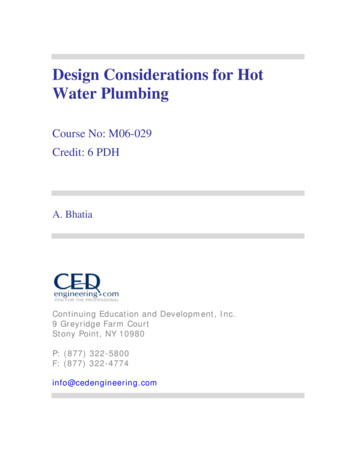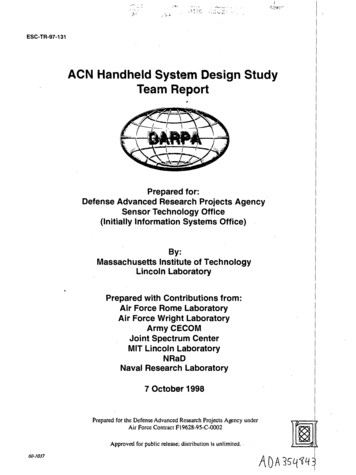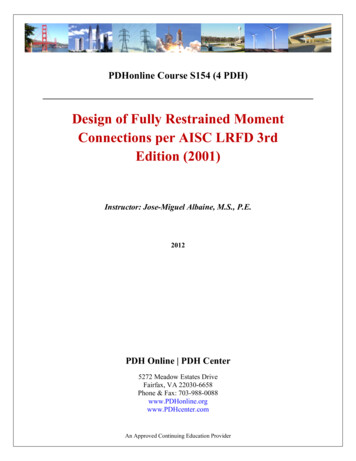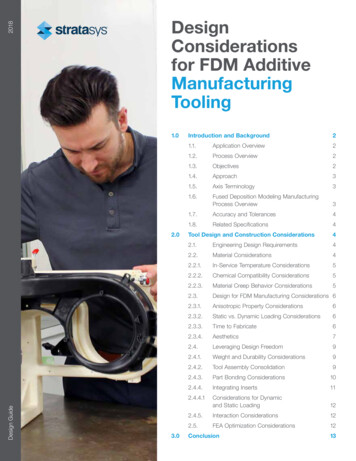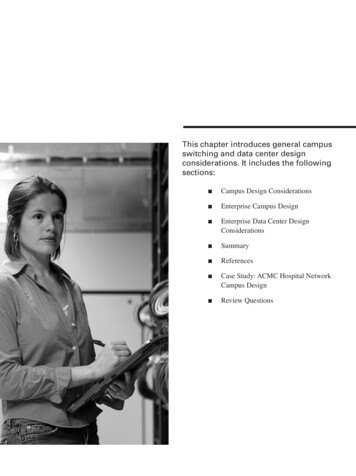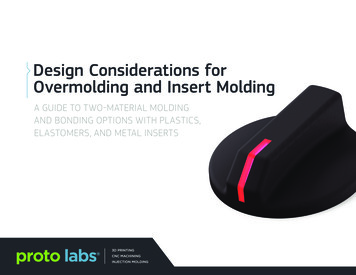
Transcription
Design Considerations forOvermolding and Insert MoldingA GUIDE TO TWO-MATERIAL MOLDINGAND BONDING OPTIONS WITH PLASTICS,ELASTOMERS, AND METAL INSERTS
Design Considerations for Overmolding and Insert MoldingOvermolding is an injection molding process thatallows an additional layer of resin to be added toan existing molded part to provide a combination ofcharacteristics that no single material can provide.One of the most common applications is to add a soft,functional, hand-friendly layer of rubber-like material,typically a TPE (thermoplastic elastomer) over ahard substrate. Another is to change or enhance theappearance or “cosmetics” of a part by overmoldingmaterial of a different color or finish to it. Overmoldedmaterials can be found on anything from medicaldevices and hand-tools to toothbrushes and asgaskets and seals within assemblies.As a manufacturing process, overmolding canprovide excellent adhesion between differentmaterials and eliminate the need to assemblematerials by hand. Because the process can beautomated to varying degrees it can be quitecost-effective. And, by reducing the complexity ofassembly, it can help reduce costs and accelerateproducts and devices to market. But most important,it can greatly enhance the range of materialcharacteristics available to a product developer. Proto Labs 1999–2017There are two primary methods for overmolding—twoshot molding and pick-n-place molding, with the formerusing a single production mold while the latter usestwo molds.Material selection for overmolding can be complicated.Substrate and overmold resins can complement oneanother, but to be effective, they have to be compatible.Choices vary not just with the application of theovermolded part, but also with the method being usedto produce it. Because process and outcomes are morecomplex for overmolding than for single-shot injectionmolding, it is helpful to seek input from resin expertswhen selecting materials.Proto Labs, Inc., 5540 Pioneer Creek Dr., Maple Plain, MN 55359 USA 877.479.3680 2
Design Considerations for Overmolding and Insert MoldingTwo-Shot vs.Pick-n Place OvermoldingLet’s first look at two-shot molding, which involvesa substrate that is molded in one material andthen quickly overmolded with another material.This is generally a highly automated process. Thesecond method is pick-n-place molding in whichan entire batch of substrate parts is molded;the substrate parts are then manually placed,one at a time, into a second mold into whichthe overmolded resin is injected to produce thecompleted parts.Pick-n-place molding uses two completely separatemolds. A batch of substrate parts are manufacturedin one mold and allowed to cool. They are thenplaced, by hand, into the second larger mold, whichaccommodates the substrate parts and leaves roomfor the overmolded material to be injected over thesubstrate. The process uses less complex equipmentand simpler molds than the two-shot methods andsimplifies and accelerates setup.There are three primary methods for two-shot molding: Transfer overmolding is a robotic procedure inwhich substrate parts are mechanically lifted out ofone mold and placed into another, larger mold. Theovermolded material is injected to fill the emptyspace in the second mold, typically while the nextsubstrate is being produced in the first mold.ComparingOvermolding MethodsFactors favoringtwo-shot molding Large productionvolume—typically over10,000 parts Modest productionvolume—typically under10,000 parts Certainty of the designand materials youwill use for the entireproduction run Need to prototype designor test materials, orpossibility that the designwill change Time and money toinvest in costly two-shotmolds and process Need to move productsand devices quickly tomarket or to meet marketdemand while two-shotmolds are being made. Need for maximumchemical bondingbetween layers Rotational overmolding is another robotic processin which the mold itself moves from one injectionstation to another to allow injection of substrate andovermolded materials. Core-back overmolding can be used only with veryspecific linear geometries. The mold is built witha sliding section that is pulled back after the firstmaterial is injected and set to make room for thesecond injected material.Factors favoringpick-n-place molding A design that specifieschemical bonding, and,through proper materialselections, can provide astrong chemical bond.While the manual placement of substrates intosecondary molds is slower than the robotic processes,it can typically complete production of low- to mediumvolumes of parts more quickly and at significantly lowercost. The biggest challenge in pick-n-place molding isthe reduction in chemical bonding between overmoldedmaterials and cool substrates. To maximize adhesion,substrates must be carefully handled to preventcontamination of surfaces that could impact adhesion.In addition, proper material selection also helps ensuregood bonding in a pick-n-place application.All three two-shot methods layer the overmoldedmaterial onto a warm substrate, which aids chemicalbonding. All three also require specialized equipmentand expensive molds, but because they are highlyautomated, they are cost effective for high-volumeproduction, typically more than 10,000 pieces, andoften 100,000 or more.This graphic depicts pick-n-place overmolding, which uses twoseparate molds. Proto Labs 1999–2017Proto Labs, Inc., 5540 Pioneer Creek Dr., Maple Plain, MN 55359 USA 877.479.3680 3
Design Considerations for Overmolding and Insert MoldingThe Role of Bondingthermoplastic elastomers, which soften when reheated,and thermoset materials, which do not soften.At the interface, adhesion can takeplace in three different ways:Bonding between resin layers helps keep thelayers from separating. Depending on the partgeometry, bonds can be subjected to several forcesthat can pull the layers apart. These include:There are two primary ways in which layers bond. One isactual chemical bonding at the interface of the two resinlayers; the other is mechanical bonding, which dependson the physical geometry at the interface. Acceptablebonding is achieved through a combination of part design,material selection, mold design, and molding process. mechanical entanglement of the polymer molecules direct tensile pull causing separation at a butt joint shearing caused by a pull parallel to the bondedinterface causing separation at a lap joint peeling that typically begins at an edge andpropagates along the interface between materialsBond strength is particularly important when one ofthe materials is an elastomer, which can flex and bepulled away from the substrate. This applies to bothChemical bonding takes place at the molecularlevel and is affected by several factors. The first isthe wetting ability of the substrate by the injectedovermolded material. Better wetting allows more contactbetween the two materials and more opportunityfor bonding. This is a factor of temperatures of thematerials, viscosity of the overmolded material, andtexture and porosity of the substrate surface. co-crystallization chemical reaction between the polymer chainsAdhesion can also entail a combination of the three, and atextured surface increases the area over which adhesioncan take place. In addition to the need for compatibility ofthe resins themselves, the presence of additives, fillers,and certain surface treatments can reduce the chemicalinteractions of substrate and overmolded materials.Molders and material suppliers can be a valuable resourcein identifying resins that both meet the designer’sperformance requirements of the completed part, andresins that are compatible with one another and ableSUBSTRATE MATERIALABS LUSTRANABS/PC CYCOLOC2950-111PC LEXAN 940-701PBT VALOX 357-1001PP PROFAX 6323NYLON 66ZYTEL 103 HSL NC010TPU-Texin 983-000000CCCCMMTPV-Santoprene 101-87MMMMCMTPE-Santoprene 101-64MMMMCMLSR-Elastosil 3003/30 A/B--MM-MTPC-Hytrel 3078CCCCMMTPE-Versaflex OM 1060X-1CCCMMMTPE-Versaflex OM 6240-1MMMMMCTPE-Versaflex OM 6258-1MMMMMCTPE-Versaflex OM 1040X-1CCCMMMOVERMOLD MATERIALM mechanical bondC chemical bond Proto Labs 1999–2017Proto Labs, Inc., 5540 Pioneer Creek Dr., Maple Plain, MN 55359 USA 877.479.3680 4
Design Considerations for Overmolding and Insert Moldingto provide maximum adhesion. Processing can alsosignificantly impact adhesion. This is particularly truein pick-n-place molding. In this process, the substrateis allowed to cool before overmolding and is bothexposed to the environment and handled during theprocess. It is critical that the manufacturer prevent theaccumulation of impurities on the substrate surface duringstorage and handling in order to maximize adhesion—an area that Proto Labs pays close attention to.Mechanical bonding can be used in place of or inconjunction with chemical bonding. When overmoldedresin flows into holes in the substrate, particularly ifthe holes are “dovetailed” to widen at the bottom, thecooled overmolded material is locked to the substrate.Other ways to enhance mechanical bonding includewrapping the overmolded material around the substrateor increasing surface area of the interface with grooves,pickets, posts, or bosses. A porous substrate provides tinyholes into which an elastomer can migrate to create amechanical bond. To prevent peeling, avoid exposed edgesof the overmolded material. A raised edge of substratematerial can protect the edges of the overmoldedelastomer where peeling could otherwise begin.Overmolding MaterialsThousands of possible combinations exist of substrateand overmolded material. A few of the more commonpossibilities are included in the aforementioned chart,but if you require special characteristics, there are manyothers that can be identified by material suppliers.Besides compatibility and adhesion, there are a number offactors that affect resin choice for overmolding. If the goalis cushioning, the thickness of the overmolded materialcan be as important as the softness of the materialitself. Thin layers, typically below 0.40 in. (10mm), willfeel hard regardless of material choice. For this reason,many consumer products will have rows of taller ribs, toincrease perceived thickness while reducing the amount ofovermolded material and increasing its flexibility. The actualflexibility of a material is not directly related to its hardnessor durometer. A better measure is flexural modulus, whichmeasures a material’s resistance to bending. A material withlower flexural modulus will feel softer. And while a varietyof resins are suitable for overmolding, there are elastomerssuch as Versaflex that can be specifically formulated forovermolding applications.If the goal of overmolding is to enhance grip, amaterial’s coefficient of friction indicates how tactile itwill be. Thermoplastic elastomers (TPEs), for example,generally have a high coefficient of friction. As in thecase of cushioning, durometer is not a reliable measureof a material’s grip. Since many resins including boththermoplastics and thermosets can have a range ofcharacteristics, it may be useful to consult experts inchoosing the right resin grade for a specific application.Overmolding vs.Insert MoldingLike overmolding, insert molding injects a resin overanother material, but instead of a plastic substrate theother material is typically metal and the injected plasticmaterial is typically a rigid plastic. Metal electricalcomponents or custom-machined metal parts areoften embedded in plastic this way. Similarly, threadedinserts can be molded into plastic parts for stronger,more durable assembly of plastic components suchas device shells. Insert molding is an alternative toinserting metal parts by either heat staking or ultrasonicwelding, processes by which a molded plastic partis locally melted to allow the insertion of a metalpart. Insert molding is more controllable and allowsbetter encapsulation than the other methods. Moldedin inserts also eliminate the need for a secondaryinsert installation process, saving time and money.Because inserts are metal, they must be placedinto a mold in which they will be encapsulated inplastic. This can be done robotically for high volumeproduction, but for low- to mid-volume productioninsertion into the mold, pick-n-place is a manualprocess. There is no chemical bonding between metalinserts and plastic, so the insert and resin componentsmust be designed for mechanical bonding.Proto Labs accepts pre-fabricated inserts, includingPEM, Dodge, Tri-Star, Spirol and Tappex.LEFT:Bonding plays an important role in overmolding.Mechanical bonding, as seen here, can be used inplace of or in conjunction with chemical bonding.RIGHT:With insert molding, the inserts used are typicallypre-fabricated metal. Proto Labs 1999–2017Proto Labs, Inc., 5540 Pioneer Creek Dr., Maple Plain, MN 55359 USA 877.479.3680 5
Design Considerations for Overmolding and Insert MoldingWhy Use Overmoldingand Insert Molding?Quick-turn ProductionRange of Applications It allows materials to be combined to providecharacteristics that no single resin can deliver. It can eliminate assembly steps,saving both time and money. It can meld materials in a way thatassembly processes cannot match. Inserts add strength and durability to parts.Overmolding can help speed products to market. Oncemolds have been created, overmolding, in any of its forms,can be a far faster process than those requiring assembly.Two-shot overmolding processes are best suited for largevolume production—more than 10,000 parts. Pick-nplace overmolding is more economical at smaller volumesin the thousands. While design and manufacturing oftwo-shot molds can take a month or more, pick-nplace overmolding can produce parts within weeks forprototyping, market testing, low-volume production, orbridge tooling while two-shot molds are being produced.In either case, however, once the mold or molds havebeen made, volume part production can be done quickly.Overmolding is widely used in industries rangingfrom consumer products to automotive and electroniccomponents, but it is particularly suited for medical andhealth care applications. Devices that contact, enter, orare inserted into the body may have to meet stringentrequirements and have challenging functions. Theymay have to stand up to heat for sterilization, endurechemical exposure, and meet standards includingFDA, USP Class VI, ISO 10993, and biocompatibility.In many cases, no single resin can meet all of therequirements. For safety and sterility, multiple materialsmay have to mate virtually seamlessly, and thisis an area in which overmolding excels. There aremany other reasons to use overmolding including:Cost ReductionPrototyping and Low-Volume RunsOvermolding can reduce production cost. Whereasstandard injection molding can combine multipleparts into a single multi-cavity mold, overmolding canproduce a single part made up of different materialswithout the need for assembly. Mold production ismore complicated, but it eliminates the recurring costof assembling thousands of parts. There are a varietyof ways to produce overmolded parts, and choosingthe right one for your needs—time to market, totalproduction volume, and likelihood of product change—can help determine which will be most efficient.Pick-n-place overmolding is ideal for low- to mid-volumeproduction. Because it is more labor-intensive thantwo-shot overmolding, production cost per part usingthis technique will tend to be higher, but it eliminatesthe extremely high cost and delay of producing complextwo-shot molds. Total cost of pick-n-place will tend to belower than two-shot below production volumes of 10,000parts. The process can also be used to produce prototypesbefore investing in two-shot molds for high-volumeproduction. If speed to market is critical, it may makesense to use pick-n-place to deliver product to marketwhile waiting for full-scale production to begin. And, inmarkets where parts are subject to frequent redesign,pick-n-place reduces risk by allowing redesign of moldsat a fraction of the cost of remaking two-shot molds.While overmolding requires more complex design,processing, and materials choice than single-shotinjection molding, it offers significant benefits: One of the most common is for comfort and grip.Soft elastomers are frequently molded over a hardsubstrate to create a safe, non-slip grip on a variety ofhand-held items ranging from hand tools to devices. Because the overmolded material is typically anelastomer, sealing, shock absorption, and vibrationdamping are also common applications. Another common application is aesthetic; thesubstrate can have an indented pattern that isfilled with the overmolded material in a contrastingcolor to create text, a logo, or other design. Overmolding can change the characteristics ofa part’s surface to give it different electrical,thermal, or other environmental qualities. It can also be used to capture or encapsulatesomething within another material.Upload a 3D CAD model at protolabs.com of yourovermolded designs to get a free moldabilityanalysis and interactive price quote within hours. Proto Labs 1999–2017Proto Labs, Inc., 5540 Pioneer Creek Dr., Maple Plain, MN 55359 USA 877.479.3680 6
inserts can be molded into plastic parts for stronger, more durable assembly of plastic components such as device shells. Insert molding is an alternative to inserting metal parts by either heat staking or ultrasonic welding, processes by which a molded plastic part is locally melted



